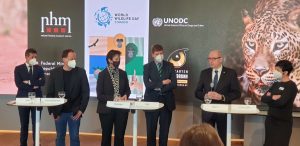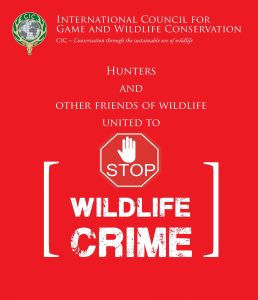
Wildlife crime was the topic of the press conference organised as part of World Wildlife Day 2022 in collaboration with the UN Office on Drugs and Crime (UNODC), the Natural History Museum Vienna (NHM Vienna), the Austrian Federal Ministry of Finance and the Schönbrunn Zoo.
The conference took place in Vienna, Austria (where the CIC has its seat) at NHM Vienna, and looked to raise awareness on the crimes that take place in the wildlife, forestry and fisheries sectors, as well as the impacts they have on biodiversity, climate and people’s livelihoods.
Discussing the role of research work in fighting wildlife crime was Dr. Katrin Vohland, Director General and Scientific Director of the NHM Vienna. The museum has been working in the fields of wildlife monitoring, molecular systematics, wildlife forensics, phylogeography and biodiversity research for many years.
They are also able to contribute through the creation of reference databases, which is achieved by making use of the 30 million objects housed at NHM Vienna, including many zoological and botanical collections of international relevance.
Alan Cole, UNODC Border Control Lead, went on to discuss the work that UNODC plays in providing capacity building and technical assistance to Member States of the UN in the prevention, detection, investigation, prosecution and adjudication of wildlife crime. Over the years, they have been able to conduct assessments in 21 countries – among the findings was the fact that corruption is a significant driver in enabling crime to take place in the first place.
Once a crime has occurred, customs was mentioned as the central point of authority in Austria when it comes to the preservation of wildlife species. Gerhard Marosi, Expert for product piracy and species protection at the Federal Ministry of Finance (Austria), stated that effective wildlife trafficking requires both experience and the use of technical equipment such as scanners and sniffer dogs.
In addition, the importance of cooperation between organisations and associations was stressed, particularly when broader health issues could be involved. An example in this regard was given, which involved birds that were smuggled into Austria which were found to have avian influenza.
The Schönbrunn Zoo was mentioned as playing a key role in both the detection of wildlife crime, and the care of smuggled live animals.
Training for wildlife detector dogs, assisting with confiscated luggage, as well as first aid and the long-term care of confiscated species, such as reptiles, were among the examples given by Anton Weissenbacher, Zoological Department Head of Schönbrunn Zoo. Once smuggled animals are put in their care, the zoo’s aim is to breed populations from the species, which is the basis for many conservation projects.
Discussing the effect of wildlife trade on reptiles was Dr. Silke Schweiger from the 1st Zoological Department, Herpetological Collection at the Natural History Museum Vienna. Habitat destruction and persecution by humans were listed as the main drivers in reptile extinction. The museum itself is able to contribute to the prevention of wildlife crime by providing their expertise to organisations, and by conducting public awareness campaigns.
The CIC was in attendance at the press conference in Vienna, and extends its praise to the organisations involved in conducting the event.
Wildlife crime is one of the many issues that the CIC is involved with through its work in conservation.
As supporters of conservation through sustainable use, we are keenly aware of what unsustainable and illegal practices can do to both ecosystems and people. Over the years, we have worked to support efforts to mitigate wildlife crime, and to raise awareness of its importance all over the globe.
For example, the CIC organised the ‘Hunters United Against Wildlife Crime’ Global Summit within the framework of the 61st General Assembly of the CIC in Milan, Italy.
The summit was able to demonstrate the impact of mobilising hunters in order to strengthen global efforts against wildlife criminals. At the same time, we were able to identify what more could be done by the hunting community to contribute towards wildlife crime issues.

